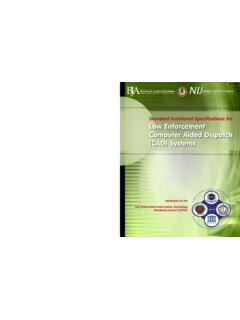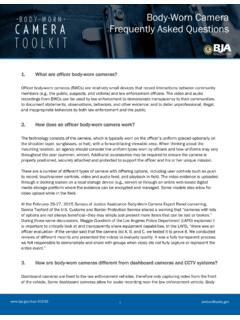Transcription of Law Enforcement Intelligence - Bureau of Justice Assistance
1 U. S. Department of JusticeOffice of Community Oriented Policing ServicesLaw Enforcement Intelligence :A Guide for State, Local, and Tribal Law Enforcement AgenciesSecond EditionDavid L. Carter, of Criminal Justice , Michigan State UniversityLaw Enforcement Intelligence :A Guide for State, Local, and Tribal Law Enforcement AgenciesSecond EditionDavid L. Carter, of Criminal Justice , Michigan State UniversityThis project was supported by Cooperative Agreement #2007-CK-WX-K015 by the Department of Justice Office of Community Oriented Policing Services. Points of view or opinions contained in this publication are those of the author and do not necessarily represent the official position or policies of the Department of Justice or Michigan State University. References to specific agencies, companies, products, or services should not be considered an endorsement by the author or the Department of Justice .
2 Rather, the references are illustrations to supplement discussion of the from the COPS OfficeJanuary 2009 Dear Colleague:This second edition of Law Enforcement Intelligence : A Guide for State, Local, and Tribal Law Enforcement captures the vast changes that have occurred in the 4 years since the first edition of the guide was published in 2004 after the watershed events of September 11, 2001. At that time, there was no Department of Homeland Security, Office of the Director of National Intelligence , Information-Sharing Environment, or Fusion Centers. Since the advent of these new agencies to help fight the war on terror, emphasis has been placed on cooperation and on sharing information among local, state, tribal, and federal agencies. The successes of community policing are evident, not just within law Enforcement , but also through agencies work with the community to protect civil liberties and civil rights.
3 A strong foundation between the police and the community also yields valuable information for fighting crime and terrorist threats. Through community policing and the wide array of approaches that fall under its umbrella hot spots, CompStat, problem-oriented policing, and Intelligence -Led Policing law Enforcement can gather and share information that will enhance public of partnership building and problem solving with the community, the private sector, nonprofit organizations, elected officials, social service providers, and other key stakeholders have created an environment in which Intelligence -Led Policing and information sharing is more viable because of the strong relationships established through community Guide serves as a road map to understanding criminal Intelligence and its related methodology, standards, processes, management, and resources.
4 In fact, nearly 85 percent of the material in this second edition is new. I am proud to add this valuable publication to the COPS Office library. My thanks to Dr. David Carter for synthesizing the vast body of law Enforcement information and Intelligence into one volume that I know will be an indispensable knowledge resource for law Enforcement agencies around the country. During these challenging times, community policing is more important than ,Carl Peed Former Director Office of Community Oriented Policing ServicesLetter from the COPS OfficevPrefaceWhen the first edition of Law Enforcement Intelligence was published, it documented unprecedented changes in law Enforcement Intelligence that occurred largely in response to the September 11, 2001 terrorists attacks. Indeed, the new initiatives reflected philosophical and operational changes that represented a geometric evolution in law Enforcement Intelligence in only 3 short years.
5 The first edition of the Guide described a broad array of cutting- edge issues and practices. At the time, it seemed implausible that such dramatic changes would occur again. Nevertheless, since the publication of the first edition, a staggering number of significant developments affecting law Enforcement Intelligence have occurred: There were only a few Regional Intelligence Centers across the that are now evolving into a nationwide network of fusion centers. The Fusion Center Guidelines had not been written. There had been no national fusion center conferences and regional fusion center groups did not exist. The Fusion Process Technical Assistance Program, a joint Department of Justice and Department of Homeland Security project, did not exist. The Office of the Director of National Intelligence (ODNI) did not exist.
6 The Information Sharing Environment did not exist. The FBI s Intelligence Directorate did not exist. The DEA s National Security Branch of the Office of Intelligence did not exist. The National Criminal Intelligence Resource Center did not exist. Many Intelligence training programs that are now taken for granted did not exist. The Joint Regional Information Exchange System which is now virtually gone was the system for information sharing and analysis. All-hazards Intelligence was not in our lexicon. Intelligence -Led Policing was in its infancy. What is now the expansive Open Source Center which, as part of the ODNI is aggressively reaching out to state, local, and tribal law Enforcement was a narrowly focused program called the Foreign Broadcast Information Service operated by the CIA. Relatively few law Enforcement agencies had any type of Intelligence capacity.
7 Suspicious Activity Reporting (SAR) was largely limited to tips and leads and there were no unified standards or formal processes to report suspicious second edition of Law Enforcement Intelligence describes these and many more changes in the philosophy, national standards, and practice of law Enforcement Intelligence while maintaining the core goal of being a primer on all things Intelligence for the law Enforcement Enforcement Intelligence : A Guide for State, Local, and Tribal Law Enforcement AgenciesviiiThe Guide is intended to support policy in law Enforcement agencies and seeks to objectively provide the best knowledge and practice of law Enforcement Intelligence at the time of publication. It is not meant as an academic work nor does it look at theoretical issues or arguments. It is not directed as a guide to the Intelligence community except to explain the roles, responsibilities, and restrictions of the Intelligence community s state, local, and tribal law Enforcement partners.
8 The Internet references cited in this publication were valid as of June 2009. Given that URLs and web sites are in constant flux, neither the author nor the Office of Community Oriented Policing Services can vouch for their current validity. Please note that some of the sites referenced require a user name and/or password to gain completing this second edition, first and foremost I want to thank Carl Peed, former Director of the Office of Community Oriented Policing Services (the COPS Office). Carl s support for both editions of Law Enforcement Intelligence was consistent, strong, and unwavering. Carl, I sincerely appreciate all you have done for this also thank the membership of the Criminal Intelligence Coordinating Council for taking the time to review the original draft of this Guide to ensure that it reflected the information needed by the law Enforcement Intelligence community.
9 Many people assisted me in the preparation of this Guide. Their contributions, large and small, helped in developing the comprehensive contents. While I hope to not leave out anyone, I particularly want to thank: Bill Harris (Delaware Information Analysis Center), Bob Hipple (Indianapolis [Indiana] Metropolitan Police Department), Bruce Parker (Brevard County [Florida] Sheriff s Office, Retired), Ed McGarrell, Steve Chermak, Natalie Hipple, and Jeremy Carter (Michigan State University [MSU]), Hal Wilson ( drug Enforcement Administration), Kathy Suey (Las Vegas Metropolitan Police Department), Kelly Stone (North Central Texas Fusion Center), Lance Ladines (Washington Joint Analysis Center), Mark Johnson (Open Source Center), Merle Manzi (Florida Department of Law Enforcement , Retired), Norm Beasley (Maricopa County [Arizona] Sheriff s Office), Ray Guidetti (New Jersey Regional Intelligence Operations Center), Rick Stephens (FBI), Ritchie Martinez (Arizona high intensity drug trafficking area )
10 , Roger Bragdon (Chief, Spokane [Washington] Police Department, Retired), Sabra Horne and Craig Manly (Office of the Director of National Intelligence ), Scott Whitney (Customs and Border Protection), and Tom Martinelli (Wayne State University).I expressly want to thank those who volunteered to review the Guide: Dan Oates (Aurora [Colorado] Police Department), Bob Casey (FBI), Ed McCarroll (Department of Homeland Security [DHS]), Kevin Saupp (DHS), Lisa Palmieri (DHS and International Association of Law Enforcement Intelligence Analysts), Mark Gage (National White Collar Crime Center) and Michael Ronczkowski (Miami-Dade Police Department). I know you were all a little surprised when you discovered the size of the also had Assistance from friends whose work went well beyond a little help, particularly reading and reviewing drafts.











